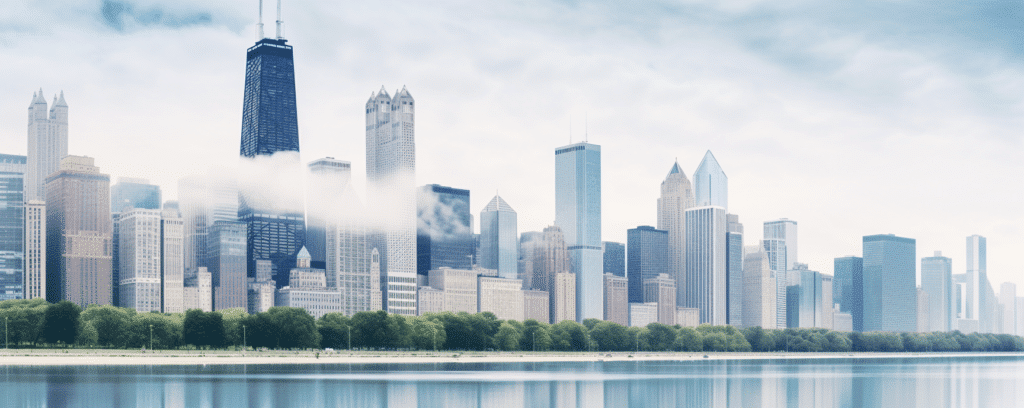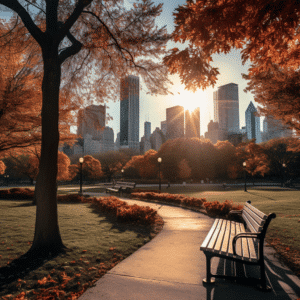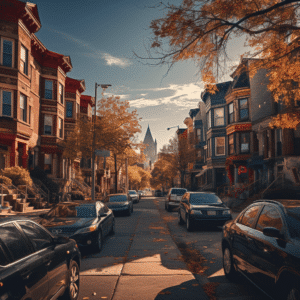
Identifying the dangerous parts of Chicago is more than just a list—it’s understanding the backdrop of violence and crime that plagues certain neighborhoods. In this straightforward guide, we break down the areas of Chicago with the highest crime rates and delve into the factors contributing to these statistics. This article provides a no-nonsense look at the areas that top the list, offering a sobering perspective on the city’s safety challenges without sugarcoating the harsh realities or spoiling the more in-depth discussions to follow.
Key Takeaways
- Chicago’s most dangerous neighborhoods are besieged by high violent and property crime rates, with West Garfield Park, East Garfield Park, Grand Crossing, and North Lawndale among those severely affected by activities such as drug sales, shootings, and robberies.
- Law enforcement and city officials are working together on strategies to combat crime, such as the Chicago Police Department’s Violence Reduction Strategy and community-based initiatives targeting the root causes of violence and fostering safer neighborhoods.
- Despite alarming crime statistics, community-led initiatives across neighborhoods are making significant strides in empowering residents, providing job training and resources, and focusing on enhancing quality of life to challenge crime and rebuild community strength.
Your search for help ends here. Let’s get started, for FREE.
The Top 10 Most Dangerous Neighborhoods in Chicago
A comprehensive understanding of Chicago’s crime scenario requires a deep dive into the core of the city’s neighborhoods, where crime is most prevalent. Some neighborhoods, unfortunately, bear the brunt of the city’s crime problem, with violent crime rates much higher than the Chicago average. This list of the ten most dangerous neighborhoods in Chicago is based on crime data, focusing on violent crimes per 1,000 residents:
- Englewood
- Austin
- North Lawndale
- Garfield Park
- West Englewood
- South Shore
- Roseland
- Auburn Gresham
- Chicago Lawn
- Humboldt Park
These neighborhoods – West Garfield Park, East Garfield Park, Grand Crossing, North Lawndale, Englewood, West Englewood, Austin, South Shore, Riverdale, and Washington Park – form the epicenter of the city’s struggle against crime. Each of these neighborhoods has its unique challenges, crime dynamics, and stories of resilience. A closer look at each of these neighborhoods will reveal what contributes to their reputation as the most dangerous parts of Chicago.
West Garfield Park

- shootings
- robberies
- burglaries
- assaults
The high violent crime rate in West Garfield Park is largely attributed to drug sales fueling violence, making the streets a risky terrain for residents.
Despite the startling crime rates, initiatives have been launched to quell the violence. The Chicago Police Department collaborates with the Mayor’s Office of Violence Reduction and the Mayor’s Office for Community Safety to implement community-based initiatives aimed at reducing crime in West Garfield Park. These initiatives aim to reclaim this neighborhood, allowing residents to no longer live under the shadow of violence.
East Garfield Park
Like its western neighbor, East Garfield Park grapples with formidable crime-related challenges. Violent crimes in this neighborhood are an astonishing 338% higher than the national average, contributing to an overall crime rate that is 266% higher. Both violent and property crimes are rampant here, casting a dark shadow over the lives of its residents.
East Garfield Park grapples with specific challenges relating to gun violence, including recent incidents like mass shootings, and concerning trends like young individuals engaging in dangerous activities with firearms. Issues commonly associated with urban areas, such as high crime rates, segregation, and poverty, directly impact the residents and businesses of East Garfield Park, leading to specific challenges related to property crimes.
Grand Crossing
Situated on the South Side, Grand Crossing paints a bleak portrait of criminal activity. Its crime rate surpasses the national average, with violent crimes being 306% higher, indicating a notable safety concern for the neighborhood. The present crime rate in Grand Crossing is alarming, with a rate of 16.08 per 1,000 residents for violent crime and 45.75 per 1,000 residents for property crime.
Factors contributing to the surge in gun violence in Grand Crossing encompass:
- Incidents of violent crime
- Domestic violence
- Poverty concentration
- Social disorganization
The rate of property crime in Grand Crossing is equally concerning, as the neighborhood ranks in the 5th percentile for safety, indicating that 95% of neighborhoods in the US are safer when compared to the national crime rate. This property crime rate further emphasizes the need for increased security measures in the area.
North Lawndale
North Lawndale, situated on Chicago’s west side, is frequently depicted as a neighborhood heavily affected by crime. The neighborhood showcases elevated levels of violent crime, painting a challenging picture for residents and law enforcement alike. Some of the violent crimes prevalent in North Lawndale include:
- Homicide
- Assault
- Robbery
- Sexual assault
The reported incidents contribute to the neighborhood’s reputation as a perilous area.
Contributing factors to the high crime rate in North Lawndale include:
- Segregation
- Under-resourcing
- Heavy policing
- Poverty
- High exposure to violent crime
These factors create a complex web of challenges that makes tackling crime in North Lawndale a particularly arduous task.
Englewood
Englewood, also located on the South Side, is well-acquainted with crime. The neighborhood is grappling with a significant incidence of criminal activity, particularly violent crimes such as robbery, assault, and murder, which have left a profound impact on the community. The neighborhood, historically known as one of Chicago’s most violent, has seen a decrease in violent crimes recently, with reports indicating a drop in shootings and homicides by over 40 percent.
However, the high crime rates in Englewood can be attributed to factors including fear of crime, physical deterioration, social disorganization, and a spike in violent crime rates observed in 2016. In spite of these challenges, Englewood’s law enforcement emphasizes street outreach, violence interruption, community-based investments for violence reduction, and the implementation of the Chicago Police Department’s Violence Reduction Strategy.
Injured in an Incident in Chicago?
West Englewood
West Englewood, situated in the city’s southern region, is infamous for its elevated crime rates. The neighborhood is characterized by elevated rates of both violent crime and property crime, indicating the presence of specific areas that are disproportionately impacted. The elevated crime rate in West Englewood can be attributed to social determinants of health, encompassing various social, economic, and physical conditions, as well as broader factors like fear of crime, physical decay, social disorganization, and community vulnerability.
Despite the grim crime statistics, there is more to West Englewood than meets the eye. The residents of the neighborhood are resilient and have been working towards creating a safer environment for everyone.
Austin

- Concentrated disadvantage
- Social disorganization
- Physical disrepair
- Poverty
- Drugs
- Economic underinvestment
Despite the challenges, efforts are underway to combat crime in Austin. Measures like community-based investments by the Mayor’s Office of Violence Reduction and collaboration with the Chicago Police Department through an anti-violence program aim to make Austin a safer place to live.
South Shore
South Shore, renowned for its stunning beaches and cultural landmarks, also battles with heightened rates of violent crimes such as murder and gun violence. The prevalent types of violent crimes in South Shore include murder, robbery, and assault. These incidents of violent crime have cast a dark cloud over the otherwise vibrant neighborhood.
South Shore’s demographic composition has seen a significant shift since 1960, from being 90% white and 10% black to 93% African American, 3% White, and 3% Hispanic. This shift has brought about changes in the neighborhood’s dynamics, contributing to the current challenges the neighborhood faces.
Riverdale
Located on Chicago’s far south side, Riverdale is a crime-ridden area where the likelihood of falling victim to violent crime is 1 in 158 and property crime is 1 in 65. Notably, the neighborhood has witnessed a series of violent and property crimes, leading to a significant safety concern for its residents.
The heightened crime rates in Riverdale can be attributed to the presence of public housing projects such as Altgeld Gardens and elevated levels of gun violence. Despite the challenges, residents of Riverdale are actively working towards creating a safer neighborhood, transforming the narrative, and changing the face of Riverdale.
Washington Park
Despite its historical significance and cultural landmarks, Washington Park holds the unfortunate title of Chicago’s most dangerous neighborhood. The neighborhood’s crime rate exceeds the average crime rate in Chicago, causing a significant safety concern for its residents. The major contributing factors to the high crime rates in Washington Park encompass physical deterioration, social disorganization, and vulnerability.
The neighborhood’s diverse demographic composition, with a 94% African American population, presents unique challenges and opportunities. While the community faces significant hurdles, it also showcases resilience and strength in the face of adversity, offering hope for a safer and more secure future.
Addressing Crime in Chicago’s Dangerous Neighborhoods
Tackling crime in Chicago’s dangerous neighborhoods is an uphill task, requiring concerted efforts from law enforcement, local government, and residents. The Chicago Police Department has implemented strategies like the Violence Reduction Strategy (VRS), which includes initiatives such as the Custom Notifications program. The strategy aims to involve at-risk individuals and groups with support, reclaim public spaces for safe use, respond to emergencies, collaborate with community organizations, and utilize data and technology for informed decision-making and resource management.
Community policing in Chicago includes the following approaches:
- Fostering cooperation between the community, the Police Department, and city agencies
- Proactively combating crime in neighborhoods
- Leading to safer communities
In addition, community-based investments and collaborative efforts, such as the Mayor’s Office of Violence Reduction and the People’s Plan for Community Safety, prioritize addressing the underlying factors of violence and enhancing safety.
Safety Tips for Navigating Chicago’s High-Crime Areas
As the city tackles crime, it’s vital for both residents and visitors to stay alert to their surroundings, particularly in high-crime zones. Situational awareness is crucial for personal safety, enabling individuals to identify potential threats, steer clear of hazardous situations, and take necessary measures to safeguard themselves.
For pedestrians, it’s advisable to remain vigilant, avoiding distractions such as using electronic devices while walking, enhancing visibility by wearing brightly colored or reflective clothing, and adhering to traffic regulations. Drivers, on the other hand, should maintain vigilance, trust their instincts, plan routes in advance, and keep doors locked and windows closed. These safety precautions offer a buffer against potential threats while navigating through high-crime neighborhoods.
Beyond the Crime Statistics: Understanding Neighborhood Dynamics
Although crime statistics cast a bleak shadow over Chicago’s dangerous neighborhoods, it’s crucial to delve deeper than the numbers to grasp the neighborhood dynamics. Community engagement holds the potential to alter power dynamics and is crucial for addressing various issues in distressed urban areas, potentially resulting in enhanced neighborhood dynamics.
Understanding the neighborhood dynamics goes beyond crime statistics and includes examining access to essential services such as:
- affordable housing
- youth development
- civic engagement
- capacity building
- leadership development
- education programs
Individual experiences, including patterns of residential mobility and incidences of victimization, have a significant influence on the shifting dynamics of neighborhoods and can impact crime rates, including quality of life crimes, and the community’s capacity to address local issues.
The Role of Socio-Economic Factors in Chicago’s Dangerous Neighborhoods
Socio-economic factors play a substantial role in shaping crime rates in Chicago’s dangerous neighborhoods. Poverty, for instance, has a strong correlation with crime rates. Neighborhoods with high poverty rates, such as Englewood and Washington Park, contribute to 50 percent of the city’s shootings, highlighting the increased vulnerability of individuals living in poverty to violent crime.
Unemployment exacerbates crime rates, as the absence of employment opportunities, particularly in the inner city, and the consequent inadequate living conditions can contribute to a detrimental cycle of criminal activity. The role of education in the context of crime is significant; residing in hazardous areas can have a detrimental effect on students’ behavior. Moreover, significant disparities within neighborhoods, even within the same race, impact homicide rates, showing the influence of income inequality on crime rates.
Community-Led Initiatives Making a Difference
Community-led initiatives have become instrumental in driving positive change in Chicago’s dangerous neighborhoods. In West Garfield Park and East Garfield Park, community-led initiatives like GPCC’s annual organizing training and Neighborhood Networks have been instrumental in building local leaders. Similarly, in North Lawndale, READI Chicago has empowered the community and reduced crime by providing job training and resources to over 1000 men.
In Englewood, the Quality of Life Initiative embodies endeavors led by the community to enhance the general well-being of its residents. It prioritizes intergenerational programs and resources, promoting healthier lifestyle choices within the community. These initiatives include:
- Community gardens
- Fitness classes
- Youth mentorship programs
- Job training opportunities
- Neighborhood clean-up projects
These initiatives depict the resilience of the residents and their determination to reclaim their neighborhoods from the clutches of crime.
Frequently Asked Questions
What part of Chicago is the safest?
The safest part of Chicago is Lincoln Park, located on the North Side of the city. While the overall crime rate in this neighborhood is above the national average, it is still considered the safest part of Chicago.
Why is O Block so famous?
O Block gained notoriety for being the center of increased gang activity and violence in the early 2010s, originally known as “WIIIC CITY” but later named after the murder of resident Odee Perry.
Is downtown Chicago safe right now?
Yes, downtown Chicago is safe to visit, but it’s important to plan according to your comfort level.
What are some of the most dangerous neighborhoods in Chicago?
Based on crime rates, some of the most dangerous neighborhoods in Chicago include West Garfield Park, East Garfield Park, Grand Crossing, North Lawndale, Englewood, West Englewood, Austin, South Shore, Riverdale, and Washington Park.
What initiatives are being taken to combat crime in Chicago's dangerous neighborhoods?
Various initiatives such as the Violence Reduction Strategy, community policing, and community-based investments and collaborations are being implemented to combat crime in Chicago’s dangerous neighborhoods. These efforts aim to address the root causes of crime and improve community safety.











